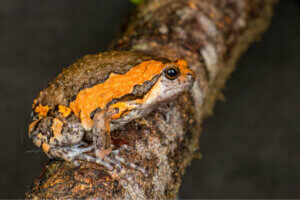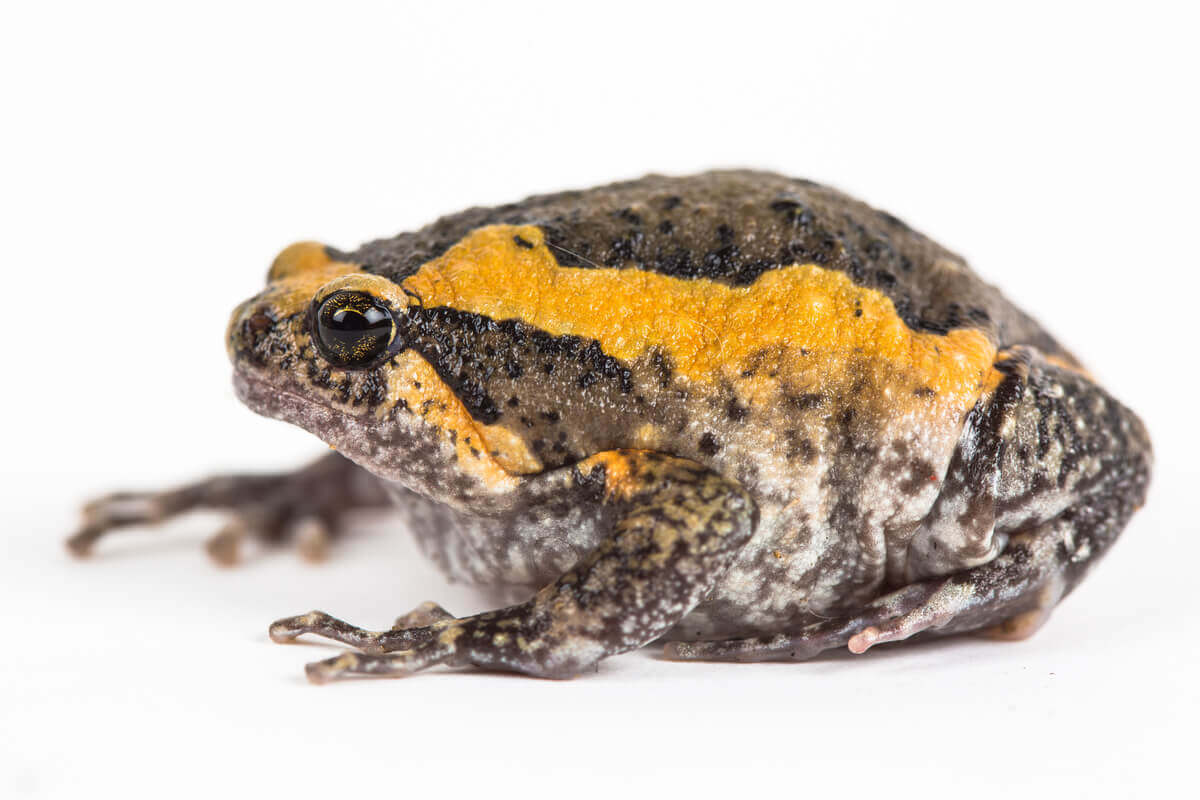Captive Care of the Banded Bullfrog


Written and verified by the biologist Ana Díaz Maqueda
The banded bullfrog, also known as the Asian painted frog, is an amphibian that’s becoming increasingly popular as an exotic pet. Although its conservation status is of “least concern”, this information needs to be updated.
It’s an undemanding animal that can even be bred in captivity. This chubby-looking frog is a good choice for those who want to dip their toes in the world of herpetology. In this article, we’ll tell you everything you need to know about the captive care of the banded bullfrog.
Initial considerations
Banded bullfrogs are prolific animals. In China, Vietnam, Thailand, and other countries, where these frogs live, their populations seem to increase despite human activity, as they’re used for food.
This frog species seems to have adapted perfectly well to the expansion of human beings and is capable of living in the same territory as people. For this reason, this animal isn’t in danger of extinction today nor does it seem that it’ll suffer significant population declines in the future.
The banded bullfrog has an average size of between two to three inches. They’re small amphibians with globe-shaped bodies with black and brown stripes and a light belly. Its head is also striking, as it’s very small for its body.
As a consequence of captive breeding, possible dormant genes have emerged that have given these frogs new colors that don’t occur in nature, such as white in albino specimens.

Captive care of the banded bullfrog
Although banded bullfrogs are considered entry-level exotic pets, these animals have very specific needs that you need to meet to ensure they stay healthy. We’ll share them with you in the following sections.
The best type of terrarium for the banded bullfrog
If you want to keep two or three banded bullfrog specimens, the terrarium must have a capacity of at least 60 liters. On the contrary, if you want to have more specimens or have them reproduce, the minimum volume of the installation should be 120 liters.
As they’re amphibians, these frogs need a lot of humidity, hiding places, deep substrate, and water in the terrarium. For these reasons, an aqua-terrarium or paludarium is the best option for this species. In any case, this frog doesn’t have swimming needs, so be careful with the depth of the water.
Paludariums incorporate both terrestrial and aquatic elements. In the case of these frogs, the aquatic area doesn’t have to be very wide or deep. If you’re going to opt for a regular amphibian terrarium, you should make sure your banded bullfrog always has a bowl of water it can submerge itself in.
This is a digger species. Therefore, the land area/substrate must be several inches deep. The best type of substrate is a mixture of rehydrated coconut fiber with small amounts of bark and leaves. Also, you can add some potting soil to thicken it.
Just as they like to dig, these frogs also love slipping through cracks. It’s a good idea to decorate the paludarium with pieces of clay pots, high rocks, and abundant vegetation so this animal can display all their natural behaviors.
You have to make sure that the rocks and heavy materials won’t fall and crush the animal.
Environmental parameters
This frog species requires similar physicochemical environmental parameters to other amphibians. These are the most important conditions that your frog’s terrarium must meet:
- The water in the paludarium or bowl should always be dechlorinated. If you opted for a paludarium for your frog, it’s best to place filters so that the water doesn’t build up excess toxic waste substances.
- The temperature inside the terrarium should be between 73 and 78°F. To reach that temperature, you must place heaters or thermal blankets outside the terrarium. These instruments can reduce the relative humidity in the air, so you need to keep an eye on this parameter.
- Humidity should always be at around 70%. This is easy to achieve if you keep your frog in a paludarium, as they conserve moisture. On the contrary, in normal terrariums, you’ll have to install a water fog or mist or spray the substrate three times a day.
- It isn’t essential to use artificial lighting, as long as you don’t place live plants inside the paludarium. Nevertheless, it’s a good idea to use it, as it’ll help define a light-darkness cycle that will keep your frog healthier. In addition, not using light means you have to supplement your frog’s diet with vitamin D3 and calcium.
The diet of the banded bullfrog
Although adult banded bullfrogs are very hungry and voracious animals, you only need to feed them every two or three days. They mainly eat ants and termites in the wild. In captivity, they’ll prey on any live insects that you offer them and fit in their mouths.
The best food for banded bullfrogs that are kept in terrariums are small and medium-sized crickets. These animals should be the foundation of the banded bullfrog’s diet. You can alternate them with other insects or larvae, such as mealworms, bloodworms, or greater wax moths.
Something that seems to be great for amphibians is that the crickets they eat are nourished with fresh vegetables and fruits, in addition to having eaten just before being predated. This seems to provide the frogs with many vitamins and other nutrients that they wouldn’t get otherwise.
Lastly, you should coat the food you offer them with a powdered vitamin supplement once a week. This way, you ensure correct vitamin and mineral balance.

As you can see, this species is easy to care for. Nevertheless, you must pay special attention to temperature and humidity, as values outside the optimal parameters we described here can quickly lead to the amphibian’s death.
The banded bullfrog, also known as the Asian painted frog, is an amphibian that’s becoming increasingly popular as an exotic pet. Although its conservation status is of “least concern”, this information needs to be updated.
It’s an undemanding animal that can even be bred in captivity. This chubby-looking frog is a good choice for those who want to dip their toes in the world of herpetology. In this article, we’ll tell you everything you need to know about the captive care of the banded bullfrog.
Initial considerations
Banded bullfrogs are prolific animals. In China, Vietnam, Thailand, and other countries, where these frogs live, their populations seem to increase despite human activity, as they’re used for food.
This frog species seems to have adapted perfectly well to the expansion of human beings and is capable of living in the same territory as people. For this reason, this animal isn’t in danger of extinction today nor does it seem that it’ll suffer significant population declines in the future.
The banded bullfrog has an average size of between two to three inches. They’re small amphibians with globe-shaped bodies with black and brown stripes and a light belly. Its head is also striking, as it’s very small for its body.
As a consequence of captive breeding, possible dormant genes have emerged that have given these frogs new colors that don’t occur in nature, such as white in albino specimens.

Captive care of the banded bullfrog
Although banded bullfrogs are considered entry-level exotic pets, these animals have very specific needs that you need to meet to ensure they stay healthy. We’ll share them with you in the following sections.
The best type of terrarium for the banded bullfrog
If you want to keep two or three banded bullfrog specimens, the terrarium must have a capacity of at least 60 liters. On the contrary, if you want to have more specimens or have them reproduce, the minimum volume of the installation should be 120 liters.
As they’re amphibians, these frogs need a lot of humidity, hiding places, deep substrate, and water in the terrarium. For these reasons, an aqua-terrarium or paludarium is the best option for this species. In any case, this frog doesn’t have swimming needs, so be careful with the depth of the water.
Paludariums incorporate both terrestrial and aquatic elements. In the case of these frogs, the aquatic area doesn’t have to be very wide or deep. If you’re going to opt for a regular amphibian terrarium, you should make sure your banded bullfrog always has a bowl of water it can submerge itself in.
This is a digger species. Therefore, the land area/substrate must be several inches deep. The best type of substrate is a mixture of rehydrated coconut fiber with small amounts of bark and leaves. Also, you can add some potting soil to thicken it.
Just as they like to dig, these frogs also love slipping through cracks. It’s a good idea to decorate the paludarium with pieces of clay pots, high rocks, and abundant vegetation so this animal can display all their natural behaviors.
You have to make sure that the rocks and heavy materials won’t fall and crush the animal.
Environmental parameters
This frog species requires similar physicochemical environmental parameters to other amphibians. These are the most important conditions that your frog’s terrarium must meet:
- The water in the paludarium or bowl should always be dechlorinated. If you opted for a paludarium for your frog, it’s best to place filters so that the water doesn’t build up excess toxic waste substances.
- The temperature inside the terrarium should be between 73 and 78°F. To reach that temperature, you must place heaters or thermal blankets outside the terrarium. These instruments can reduce the relative humidity in the air, so you need to keep an eye on this parameter.
- Humidity should always be at around 70%. This is easy to achieve if you keep your frog in a paludarium, as they conserve moisture. On the contrary, in normal terrariums, you’ll have to install a water fog or mist or spray the substrate three times a day.
- It isn’t essential to use artificial lighting, as long as you don’t place live plants inside the paludarium. Nevertheless, it’s a good idea to use it, as it’ll help define a light-darkness cycle that will keep your frog healthier. In addition, not using light means you have to supplement your frog’s diet with vitamin D3 and calcium.
The diet of the banded bullfrog
Although adult banded bullfrogs are very hungry and voracious animals, you only need to feed them every two or three days. They mainly eat ants and termites in the wild. In captivity, they’ll prey on any live insects that you offer them and fit in their mouths.
The best food for banded bullfrogs that are kept in terrariums are small and medium-sized crickets. These animals should be the foundation of the banded bullfrog’s diet. You can alternate them with other insects or larvae, such as mealworms, bloodworms, or greater wax moths.
Something that seems to be great for amphibians is that the crickets they eat are nourished with fresh vegetables and fruits, in addition to having eaten just before being predated. This seems to provide the frogs with many vitamins and other nutrients that they wouldn’t get otherwise.
Lastly, you should coat the food you offer them with a powdered vitamin supplement once a week. This way, you ensure correct vitamin and mineral balance.

As you can see, this species is easy to care for. Nevertheless, you must pay special attention to temperature and humidity, as values outside the optimal parameters we described here can quickly lead to the amphibian’s death.
All cited sources were thoroughly reviewed by our team to ensure their quality, reliability, currency, and validity. The bibliography of this article was considered reliable and of academic or scientific accuracy.
- Andrew Tillson Willis. (February, 2014). Asian Painted Bullfrog Care. Reptiles Magazine. Disponible en: https://www.reptilesmagazine.com/asian-painted-bullfrog-care/
- Department of Agriculture and Food, Western Australia. (2008). Asian Painted Frog (Kaloula pulchra) risk assessments for Australia. Amanda Page, Win Kirkpatrick and Marion Massam.
- Kuangyang, L., Zhigang, Y., Haitao, S., Baorong, G., van Dijk, P.P., Iskandar, D., Inger, R.F., Dutta, S., Sengupta, S., Uddin Sarker, S. & Asmat, G. 2004. Kaloula pulchra (errata version published in 2016). The IUCN Red List of Threatened Species 2004: e.T57855A86163405.
This text is provided for informational purposes only and does not replace consultation with a professional. If in doubt, consult your specialist.








